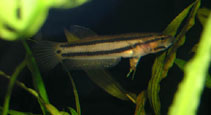| Family: |
Osphronemidae (Gouramies), subfamily: Macropodusinae |
| Max. size: |
6.7 cm SL (male/unsexed) |
| Environment: |
benthopelagic; freshwater; pH range: 4.4 - 5.7; dH range: 10 |
| Distribution: |
Asia: Borneo. |
| Diagnosis: |
Dorsal spines (total): 0-1; Dorsal soft rays (total): 9-11; Anal spines: 0-1; Anal soft rays: 24-27; Vertebrae: 31-32. Differs from other member of the Betta unimaculata group by possessing the following combination of characters: dorsal fin ocellus; body red in color; caudal fin with transverse black and red bands; opercle with large red blotch in mature male; vertebrae 31-32 (mode 32); dorsal-fin rays 9-11 (mode 10); anal-fin rays 25-28 (mode 27); pectoral-fin rays 13-14; lateral scales 32-33 (mode 33); subdorsal scales 6-8 (mode 7); predorsal scales 21-24 (mode 23); predorsal length 62.3-66.7% SL; head length 30.4-33.3% SL; anal-fin base length 43.2-49.2% SL; dorsal-fin base length 12.2-15.7% SL; lower jaw length 38.0-54.0% HL (Ref. 56613). |
| Biology: |
Inhabits shallow (about 30 cm deep) near stagnant pools along stream bed with substrate consisting of clay (Ref. 56613). Occurs also in waterfalls with fast flowing clear water; occupies small pools in tributaries and quiet pools along the main confluence of the river (Ref. 56613). A mouth brooder (Ref. 56613). |
| IUCN Red List Status: |
Vulnerable (VU); Date assessed: 28 December 2018 (B1ab(iii,v)) Ref. (130435)
|
| Threat to humans: |
harmless |
Source and more info: www.fishbase.org. For personal, classroom, and other internal use only. Not for publication.

